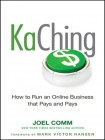KaChing: How to Run an Online Business that Pays and Pays Comm, Joel (books for 8th graders txt) 📖

Book online «KaChing: How to Run an Online Business that Pays and Pays Comm, Joel (books for 8th graders txt) 📖». Author Comm, Joel
In terms of technical demands, you won’t need to know much more than how to do Control-C (copy) and Control-V (paste) on your keyboard in order to start making money.
The Big Launch!
Creating an information product takes time and effort. The process of creating the product can take several months if it’s a full-length book—or even just a 100-page e-book. Writing the sales copy can take time and money, and you still have to design and publish the sales page and start building your network of affiliates.
At some point though, you’ll be ready to start selling.
Now you could start slowly: Make the product available, put up a link on your web site, and start directing your readers toward your sales page. You’ll hear a quiet but steady tinkle of KaChings. But that would be a waste of a valuable opportunity.
A launch is a tool that you can use to generate publicity, provoke word-of-mouth recommendations, and build the kind of buzz that brings even more sales. It’s your product’s birthday, a time to celebrate, throw open the doors, and get those cash registers ringing.
The preparation for a launch begins a long time before the launch itself. Most of that work will take place behind the scenes, but when you leak small snippets of what you’re up to, you can help to build anticipation so that buyers are ready for your big announcement. You don’t just want people to be interested in what you have to offer when you launch; you want them lining up with their wallets out.
For example, in November 2009, I launched a new online TV show. Obviously, my production team and I had put a huge amount of effort into creating the content, filming the action, and editing the footage. In order to prepare people for the show and to make sure that we were starting with an audience, we created a short teaser that we put on YouTube. I then posted a series of tweets that built interest.
The first tweet, posted on October 25, said simply:
“Saw finished edit of the NEW Joel Comm Show, to debut in mid-November. You are going to love it!”
Note that there was no link there and no further information. I wanted my followers on Twitter to ask questions. By holding information back, I built their curiosity.
Five days later, I went some way toward satisfying that curiosity by posting this tweet:
“It’s the World Premier of the teaser for the NEW Joel Comm Show! ->http://TwitPWR.com/jcshow/- enjoy and plz RT! #joelcomm”
I followed that tweet up a few hours later with this one:
“Would love to hear more comments on the teaser video for the NEW Joel Comm Show ->http://youtube.com/joelcomm- Premiers in November!”
As of this writing, we’re still at least two weeks away from the first show and at the moment, my followers can’t do anything. They certainly can’t watch anything, and I’m not selling anything. But I’ve already told them that something is coming, I’ve shown them a neat one-minute teaser, and by asking for their opinion, I have them talking about it. The excitement is building so that when we launch, people will be ready.
This kind of preparation is vital for getting the most out of launch day. It gives you the time to guide leads through that four-step sales process that ends with “pay me.” It means that in the weeks before your product is available, your market will already be familiar with you. They’ll have checked out your web site, followed you on Twitter, and joined your Facebook fan page. They’ll already be willing to trust you, and they’ll want to be a part of your success—and enjoy success themselves—by buying your new product.
And that preparation can make money, too. When Darren Rowse of ProBlogger used Twitter and his weekly newsletters to generate interest in his new photography e-book, he received both valuable feedback and orders for 50 copies, enough to cover his expenses.
The launch day itself becomes an opportunity, not to convert those leads (they should already have been converted; you’ll just be giving them a way to spend their money), but to bring in new leads. Some of those leads will be converted right away by the persuasive power of your sales letter. Others will start going through that four-step sales process and buy from you in the future.
The main job of launch day is to attract attention, and there are lots of different ways to do that. Giveaways always work well. The best example occurred in July 2009 when Moonfruit, a web site development company that’s part of SiteMaker, wanted to celebrate its tenth year in business: It chose to give away one MacBook Pro every day for 10 days. To enter the running, all Twitter users had to do was post a tweet with the hashtag “#moonfruit.” Twitterers could post as many tweets as they wanted, with each tweet increasing the chances that they’d be selected. (Third-party applications like Twiveaway and Tweetaways automate the process of selecting a random giveaway winner and even notify them for you.)
The tweets came in at a rate of 300 posts per minute. Messages containing the hashtag were taking up almost 3 percent of Twitter’s entire communications. For days, #moonfruit was the most popular trending term—and might have remained so if it hadn’t mysteriously disappeared from the list of trending topics. Moonfruit’s web site traffic increased by a factor of eight and sign-ups went up 100 percent.
That wasn’t a launch (although you could call it a relaunch), and the idea wasn’t completely original. Squarespace, a rival web site builder, had already tried something similar but fluffed it. Promising to give away 30 iPhones in 30 days, Squarespace instead handed out gift





Comments (0)